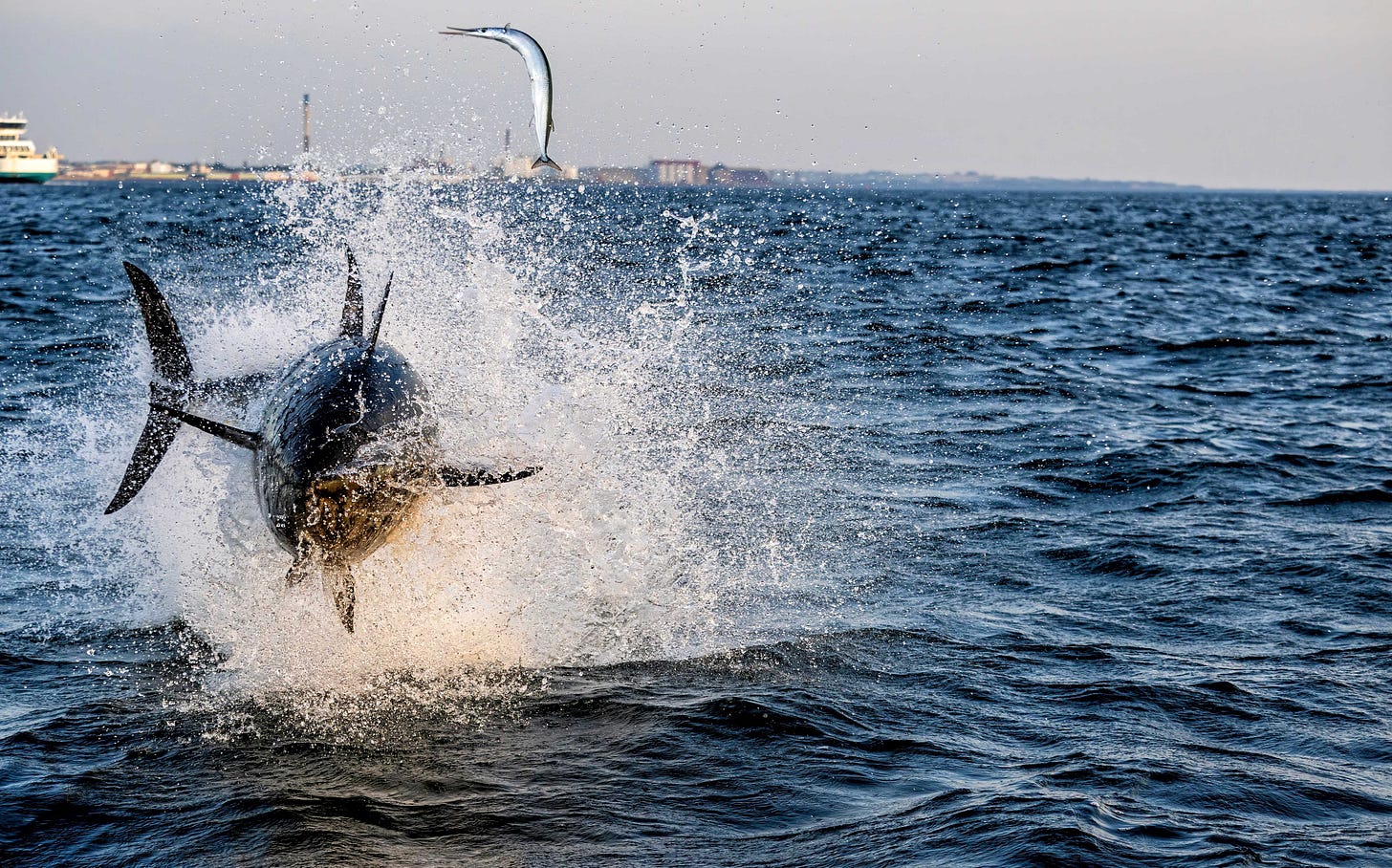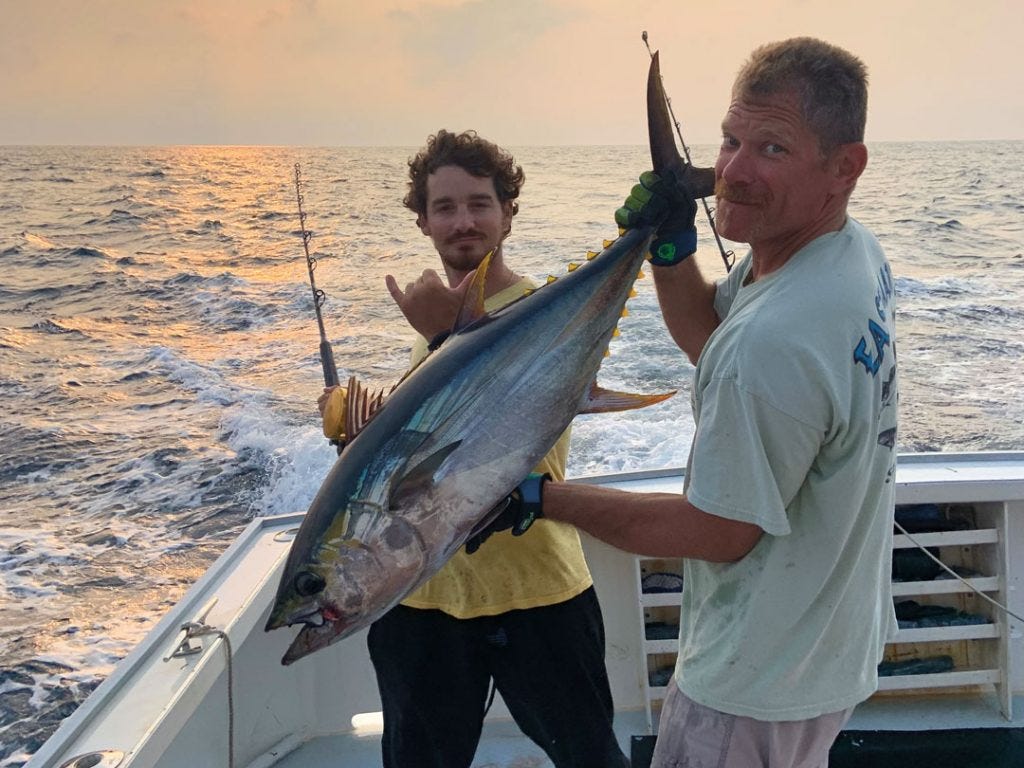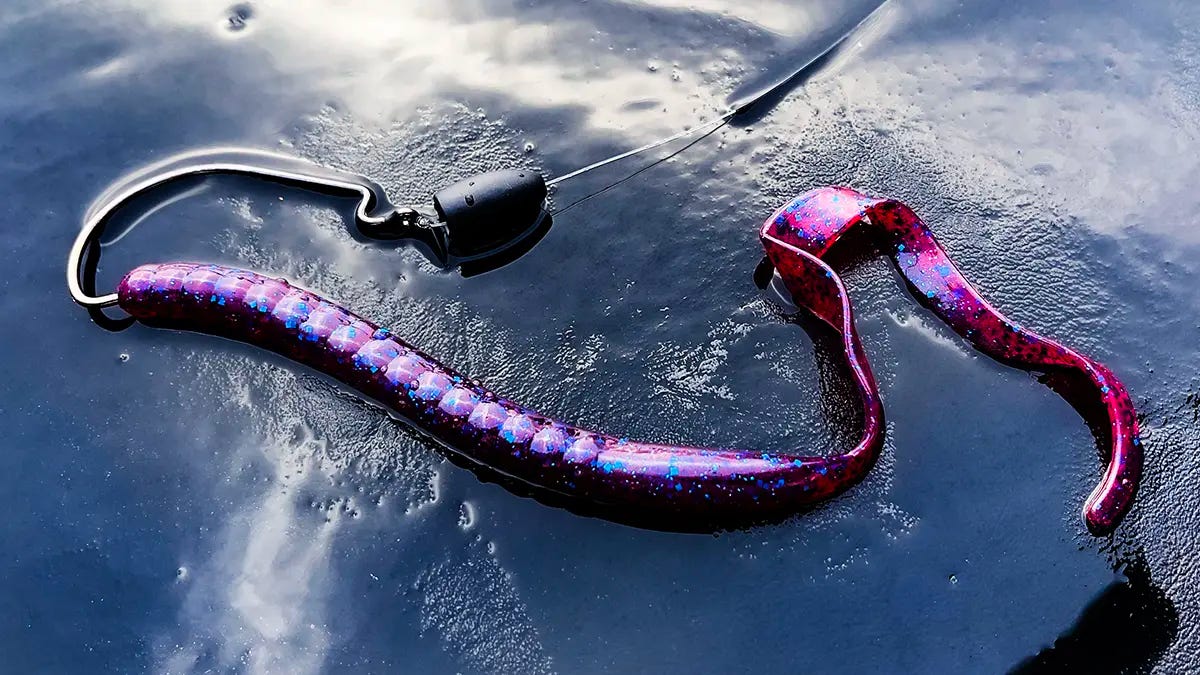The maritime rule of salvage has its origin in Roman law, which dictates that one who preserves or improves upon the misplaced property of another is owed compensation, even if the service was not requested. Let’s get out the internet trawler and get to work…
🎥 | Dogtooth and YFT of Frederick Reef: Nomad Odyssey —> The pinnacle of Tuna & Dogtooth high-speed trolling with two legends of the game. Incredible underwater sights and sounds from a remote Aussie destination fishery.
Fishing Reports | OnTheWater - FishermanMag - HullTruth - MAFishReport
Tackle Reviews | GearSay - Saltwater Edge - TackleTour - StripersOnline
Giant Bluefin of Sweden Q&A feat. Robin Galczewski
Up until about 4-days ago, the only tangential connection I had felt between Bluefin Tuna and Sweden was the customary pulse of a progressive house track queued up for greylight transit to the Regal Sword. Unbeknownst to me, a generational resurgence of the Atlantic’s apex sportfish has seen the northern migration of these cold-water leviathans re-expand into the narrows where the North Sea meets the Baltic. And not unlike the captivating hook of an EDM anthem, the inspiration to do some digging into this story came courtesy of a viral moment of exhilaration captured by Robin Galczewski. Through our brief exchange, I came to understand the greater significance of the species return, while realizing you don’t need a rod and reel to truly appreciate the power of Bluefin.
Q - Last Fall, an article from the Nordic Times cited a miraculous return of Bluefin Tuna to Swedish waters, with the first regular sightings since the 1960s. What is the historical significance of tuna in your region? How important is the return of this species?
A - The historical significance faded through the years, at least for the average Swede or Danish resident, but many fishermen knew these amazing fish had once roamed the ocean between us. But it was more like a fairy tale. Maybe if you were lucky, you knew someone who actually seen them.
According to scientists, they have been here for a very long time, but it was not until 1944 that sportfishing started in Öresund, despite the blockade during World War 2. In 1945, the Tunas were plentiful and you could fish freely. Two main methods were used: Rod and reel, and with a barrel. When the tuna were hooked, they threw the barrel overboard and followed it, to later haul it in. But in the early 60s, the Tunas were all gone, and all that remained were some old photos, stories, and a small museum in the Fishing village Råå that has a Bluefin Tuna exhibition, still to this day.
But around 2015, stories of sightings started to be rumored. And in 2017, someone caught a Tuna on video, and soon the SLU (Swedish University of Agricultural Sciences) started their tagging program. Every year they became more and more successful, tagging more fish, alongside more sightings by boaters, and today they are back in full force. We can't fish for them; only boats with a license from SLU and the tagging program can fish for them. But tourists come from far away just to see these fish.
In both Sweden and Denmark, we have fishing vessels that used to make their living taking people Cod fishing. But in Sweden, you cannot catch Cod in this region anymore, which means they lost a lot of their business. But now, during Tuna season, they fill their boats with people who want to see these amazing animals, creating a new business opportunity after the Cod restrictions. The Tunas very often jump, and all spectators scream with joy. And mixed in with Seals and Porpoises, it is an incredible scenery. To be honest, there are plenty of species that we see less of in our waters, like the Cod. So to see the Bluefin Tunas come back gives us hope. It is a win.
Q - With Tuna being a 'protected' species in Sweden, do you see any future angling opportunities? For research or recreational purposes?
A - For sport fishing, I don't know if or when we will get the chance. Sweden is very protective of their fish and waters, and there are some freshwater species that have made a very good comeback that you still can't fish for. I truly hope we will be able to fish for them and get a quota like Norway did, so we can have a productive fishery but also a well-regulated one. However, that fishery would need to be further offshore in my opinion, like Kattegatt/Skagerack, because hooking a Tuna in Öresund would be very difficult to get to the boat without another boat crossing your line. Additionally, the survival rate for catch and release might be very low due to lower oxygen levels in Öresund. It is still illegal in both Sweden and Denmark to fish for them, but I think there is some hope for sport fishing within a couple of years. For now, the tagging program continues, and the boats and crews who apply and get approved are the ones that will be able to fish for them.
Q - You have taken some stunning photography of your local Bluefin that have been widely-shared in the last few weeks. What moments have inspired your passion for these fish? What makes these experiences unique? How did you get into wildlife photography?
A - It was not just moments that inspired me, it was my entire life. I was born and have fished this region my entire life. My father always told me stories about these huge Tunas in Öresund when I was a kid. Never in my lifetime did I think I would ever see them, to me, they were only stories from a long time ago.
But once I heard about the sightings, I followed the progress of their comeback very closely and two years ago I felt like it was time to try to see them myself. I gathered all the information I could, and my friend (the same friend who filmed the video of me when I took the viral picture) and my family went out to sea to try to find them. We drove for hours looking at spots I knew they had been seen, but found nothing. Hours went by, and suddenly my son, who looked behind the boat, saw something. Everyone turned around, looked, and suddenly this huge Tuna leaped so far over the surface, it was insane. It jumped like this three times, and we were screaming like crazy. To me, this might just as well be a unicorn, it was that crazy. I have seen plenty of Tuna since, but not a single one jumped like this. It was almost like it was introducing itself.
We did not see a single other tuna that after, yet we could not be happier. But on our way home, just outside Kronoborg Castle (the very same castle Shakespeare used as inspiration for Hamlet), we saw something at the surface and I told my friend to slow down. Then the ocean exploded. We saw Tunas everywhere, jumping and chasing Garfish. For about an hour we watched this incredible scenery take place, and it was indescribable. See the video below.
So, the trip out that first year and the year after, I mostly focused on taking videos, but this year I decided to put all my effort into trying to get a good picture. Most days, jumping tuna is not difficult to find. The problem was the backlighting or closing distance to these fast fish. Your best bet is to find escaping Garfish, focus on them, and hope a tuna comes after. So I tried for some time, got a few fish on camera, but absolutely nothing to be proud of. I was really frustrated and felt like I missed my opportunities. We were about to drive home when my youngest son pointed at the surface just in front of us and said there was something there. And once again, the surface exploded with a big Tuna chasing a Garfish, and I quickly took some shots and got totally splashed. I turned around and saw my friend laughing with his phone in his hand, capturing the entire sequence. At the moment, I had no idea if I got the shot or not. It was not until I got home that I actually noticed the Garfish in the right corner and in perfect focus. I felt amazing being able to capture, for me, "a unicorn" - the fish of legends. Something I never thought I would see in my lifetime. I can't even explain the feeling.
Advice for others who want to get into wildlife photography? I am actually not a wildlife photographer. I work with media in the fitness industry, but I have always loved wildlife and, most of all, the ocean. So, if I were to give one piece of advice, it would be something I think everyone agrees on: just go out there. Spend time, and the opportunity will come. And when it comes, be ready, because it might happen really fast, like a giant tuna. While waiting for the opportunity, enjoy the wildlife. There is nothing better.
Arapaima: The Fish of 5000 Casts or More (CortlandLine) - “I hooked my first Arapaima and it felt just like setting the hook into a log. Without losing any time, it took off peeling 150 yds or so of backing in seconds. A powerful, amazing run, with head shakes and jumps. He towed me around which I thought could possibly work in my favor landing him, I was wrong. The sight of such a fish jumping and splashing so loud, so close to me while floating slightly higher from the water level is an image that is engraved into my brain. We played Tug o’ war deep for 30 minutes until I was able to land him. Estimated at 130 to 140 pounds. Unbelievable, these fish are very thick, have huge shoulders and are so heavy. I was amazed at the Jurassic look, long fins, the red coloring towards the tail, the textures in the scales and what looks like laser engraved designs in a shovel shaped head. Eyes are pretty small in proportion to the size of the rest of the fish and a square mouth that was as hard as a rock. An incredible creature with ancient genetics.”
Fall Fishing In the Canyons (OnTheWater) - “If the blue water is up on the flats or pushed further north into the 50-fathom line, you’re likely to find bigger yellowfin as well as white marlin and mahi up on that temperature break. I have caught monster wahoo in 300 feet in September in 68-degree green water a mile off the warm edge. I have caught yellowfin on either side of it. If the edge has weed lines near it, it’s invariably loaded with mahi. My biggest marlin, a scary-sized blue, absolutely crushed our spread in 75-degree blue water in Veatch Canyon in late September 2012. Multiple 300-pound swordfish have come around the fall equinox. The crazy bigeye and tuna chunk bite in Fishtails happened in September 2014 and lasted the bulk of the month. Almost any day during that bite, 50 to 200 boats clustered in the Tails, each boat filling their fish box with 70- to 80-pound yellowfin and 150-pound bigeye. It’s all on come late September!”
The Modern Texas-Rig (Wired2Fish) - “While you can easily find and fish offshore spots without high-end electronics, DeFoe explains how he uses 360 sonar to visualize a spot’s makeup and location. From there, he makes lure choices based on the structure and cover and how fish are positioned. Knowing distance and direction, he can make accurate casts to fish-holding areas, whether deeper grass, brush, or rock formations. DeFoe demonstrates how making repeated casts to the same spot can lead to numerous fish when they’re grouped up.”
Spicy Tuna Crispy Rice Recipe (MarlinMag) - Preparation: 1) Prep rice, cover, and store in the freezer for about 30 minutes. 2) Cut the tuna into small squares and mix in the mayo, sriracha and soy sauce; cover with plastic, and store in the refrigerator for approximately 30 minutes. 3) Remove the rice from the freezer, and fry in vegetable oil at a high temperature until golden brown on both sides. 4) Top rice squares with a dollop of the tuna mixture, and garnish with jalapeño, sesame seeds, scallions and cilantro, if desired.
Thanks for reading The Weekly Salvage, until next week!
Have feedback or want to learn more?
Reach out to us on IG @Blowin_We_Goin










